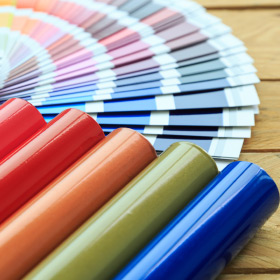About Powder Coating
What is powder coating?
Powder coating is an exciting method for finishing products through the application of tiny dry particles. For this reason, powder coating is sometimes referred to as "dry painting".
The main difference between a conventional liquid paint and a powder coating is that a powder coating does not require a solvent to keep the binder and filler parts in a liquid suspension form.
Rather than applying the paint in a wet state, we simply use a modern, clean, and efficient electrostatic powder coating process that relies on the attraction between charged particles that are fused together. This process is generally less prone to mistakes than traditional wet spray. Further, powder coating does not require the use of harmful chemicals.
After the parts are coated with powder, it is crucial to cure them under heat. The heat in the oven will cause the powder to melt and form a protective “skin” around the part. At this point, the powder bonds not only to itself but also to the part. The powder may be a thermoplastic or a thermoset polymer. It is usually used to create a hard finish that is tougher than the conventional paint. It gives the paint its increased durability and professional look.
Advantages of Powder Coating
There are several advantages of powder coating over conventional liquid coatings:
- Powder coatings emit zero or near zero volatile organic compounds (VOC).
- Powder coatings can produce much thicker coatings than conventional liquid coatings without running or sagging.
- Powder coating overspray can be recycled and thus it is possible to achieve nearly 100% use of the coating.
- Powder coating production lines produce less hazardous waste than conventional liquid coatings.
- Capital equipment and operating costs for a powder line are generally less than for conventional liquid lines.
- Powder coated items generally have fewer appearance differences between horizontally coated surfaces and vertically coated surfaces than liquid coated items.
- A wide range of specialty effects is easily accomplished which would be impossible to achieve with other coating processes.
- Comparing to liquid coating, curing time is significantly faster with powder coating.
The powder coating process
The powder coating process involves three basic steps:
- Part preparation and/or the pre-treatment
- The powder application
- Curing
What Can Be Powder Coated?
Typically, any metal object that can hold the electrostatic charge needed to affix the sprayed powder and can tolerate the high heat levels required during the curing process, aluminium, mild steel, galvanised and stainless steel can all be powder coated.
What colours are available?
SPC are proudly working with both Dulux and Interpon/Akzo Nobel and have access to all colours supplied by these suppliers.
For full list of colours available please refer to colour selector charts supplied by Dulux, Interpon/Akzo Nobel.
|
|
|
|










